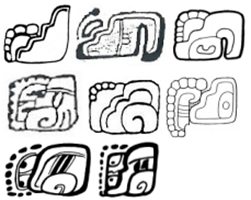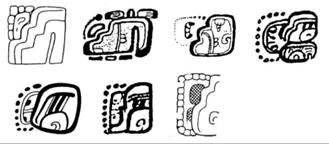
K&L.p39.#7
T’AB[ji]

![]()

TOK.p17.r4.c2 BMM9.p21.r2.c4 StuartEtAl-GoP.pdfp35.#1
T’AB T’AB T AB[yi]
![]()
![]()


![]()
![]()

JM.p223.#1 JM.p223.#2 JM.p223.#4 JM.p224.#1 T843 StuartEtAl-GoP.pdfp22.#2.2 StuartEtAl-GoP.pdfp37.#1.2
T’AB[yi] T’AB[yi] T’AB[yi] T’AB[yi]

![]()
![]()
M&L.252.ZY1 Gronemeyer-FtG.p2.fig2.a Gronemeyer-FtG.p4.fig4.b
T’AB[yi] T’AB[yi?] ] T’AB[yi?]


BMM9.p15.r1.c3 StuartEtAl-GoP.pdfp35.#2.1&2&3&4
T’AB T’AB.yi


![]()
![]()
![]()
JM.p223.#3 JM.p224.#2 Zender-TRGiCMW.p12.c2.fig10.D1 Stuart Greene
PAL TS F8/O8 PAL TS F8/O8
T’AB[yi] T’AB[yi] T’AB[yi] T’AB[yi] T’AB[yi]
![]()
![]()

StuartEtAl-GoP.pdfp13.#1.2 StuartEtAl-GoP.pdfp13.#2.2 StuartEtAl-GoP.pdfp20.#2.2
T’AB.ji



BMM9.p15.r7.c1 = TOK.p22.r4.c4 TOK.p25.r4.c4 StuartEtAl-GoP.pdfp35.#4.1&2&3
T’AB T’AB T’AB T’AB:yi T’AB:yi
· No glyphs given in K&H.
· All other sources give T’AB but JM gives TAB: Dorota Bojkowska confirms many, many modern articles give T’AB, so JM probably outdated. JM on FAMSI website (updated by Helmke) have moved the glyphs from T to T’.
· See alay for more glyph examples.
· Variants (3):
o A. Abstract:
§ Outline of steps ascending from left to right.
§ What appears to be a protective covering of blood drops above (Gronemeyer-FtG.p3.l+3: [the blood drops are a] representation of the footprint ascending a stairway).
· Dorota Bojkowska: the drops might have evolved from the toes of the foot (other interpretations not known).
· TOK has an example with a foot instead of blood drops.
§ Optionally, “darkness” within the “blood drops”.
§ Optionally, a slightly curved vertical line or bar with two vertically stacked touching dots attached halfway up the middle of the right side (wooden support for the steps?) – Dorota Bojkowska: wooden platform to make the steps, e.g. stages built for performing on during the ceremony.
o B. God Head (God N) – older god with:
§ Cross-hatched head covering.
§ Cross-hatched forehead ornament is part of the head covering.
§ God head is interchangeable with the steps.
§ The “footprint” is optional.
§ Do not confuse this with the visually similar “UHMAN”. That it sometimes has a scroll between the mouth and the back of the head does not make it “UHMAN”:
· This is merely an infixed yi, whereas in “UHMAN” it is a much more extensive and curling spiral (which would rarely be mistaken for a yi).
· The distinguishing characteristics of T’AB which “UHMAN” never have are:
o Sunken cheeks due to a toothless mouth.
o A cross-hatched head covering.
§ This logogram is considered to be Pawahtuun / God N.
o C. Skull:
§ The forehead ornament is similar to one of the ones for the god head variant: a bold-T within a cartouche with a XUKUB-like element below it.
· Note that although it is not at all clear that the Maya associated death with “ascending to heaven”, nevertheless, the god head and the skull variants meaning “ascend” do suggest some concept of rising (perhaps) when dying.
· Zender-TRGiCMW.p11.c1.l+17:
o Transliteration: T’AB-yi 6-?-CHAN-na NAAH-la 8-?-NAAH U-K’ABA’ yo-OTOOT-ti xa-MAN?-na.
o Transcription: t’ab[a]y-i-Ø wak ?-chan naahal waxak-?-naah, u-k’aba’ y-otoot xaman.
o Translation: He goes up to 6 ?-Sky, (to) the Northern 8-G1 Edifice, (which is) the name of the house of the north.
o Dorota Bojkowska: t’abay means “raised up”, but not passive, and often present tense.
o Sim: t’abay appears to the medio-passive form of a transitive verb t’ab.
· The initial sections of Boot-OOO give some information about the various forms of T’AB in connection with the PSS.
o In this context, it seems to mean “to present” rather than “to ascend”. Perhaps an object was lifted up high in presenting it (e.g. to a crowd) and the verb hence acquired the extended meaning of “to present”.
o It is unclear to me whether the “presenting” refers to the inscription on the ceramic or the ceramic itself.
· k’al, na’, and t’ab are translated as “to present” in English, but they are quite different types of “presenting”:
o k’al: a ritual object (e.g. a headband or stela) is the object of k’al.
o na’: a human being (e.g. a bride or prisoner) is the object of na’.
o t’ab: a ceramic (or perhaps the inscription / painting on the ceramic) is the object of t’ab.


Gronemeyer-FtG.p2.pdfp2.fig1 = MHD (Grube)
IKL Lintel 1 glyph-block B IKL Lintel 1 glyph-block 2
<t’a:ba>.yi
· Gronemeyer-FtG.p1.l-3: a unique instance of syllabic substitution for the typical “step verb” T843 T’AB?
· MHD uses a slightly different system of glyph-block labelling, where MHD’s glyph-block 2 = Gronemeyer’s glyph-block B.
· IKL is Ikil, a site in the state of Yucatán, in modern-day Mexico.
· That this is a unique instance can be confirmed by a search in MHD on “bllogosyll contains t’a” and “bllogosyll contains ba” and“bllogosyll contains yi”, which indeed yields exactly this one hit. In fact, even the first two clauses are already sufficient to establish this. That yields two hits, but the second hit is not a syllabogram spelling of t’a-ba è t’ab but instead a “false hit” caused by a possible T’AB (MHD searches are not, appropriately and fortunately, case sensitive).